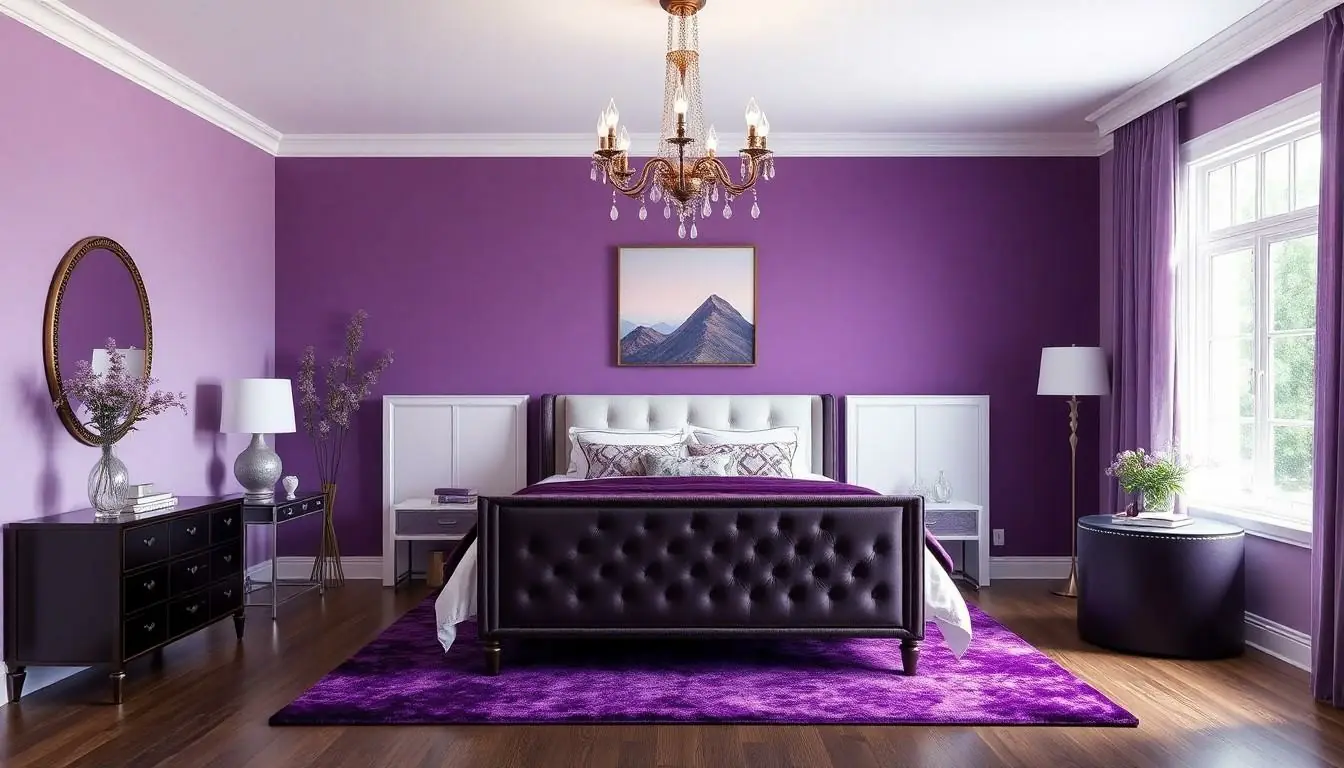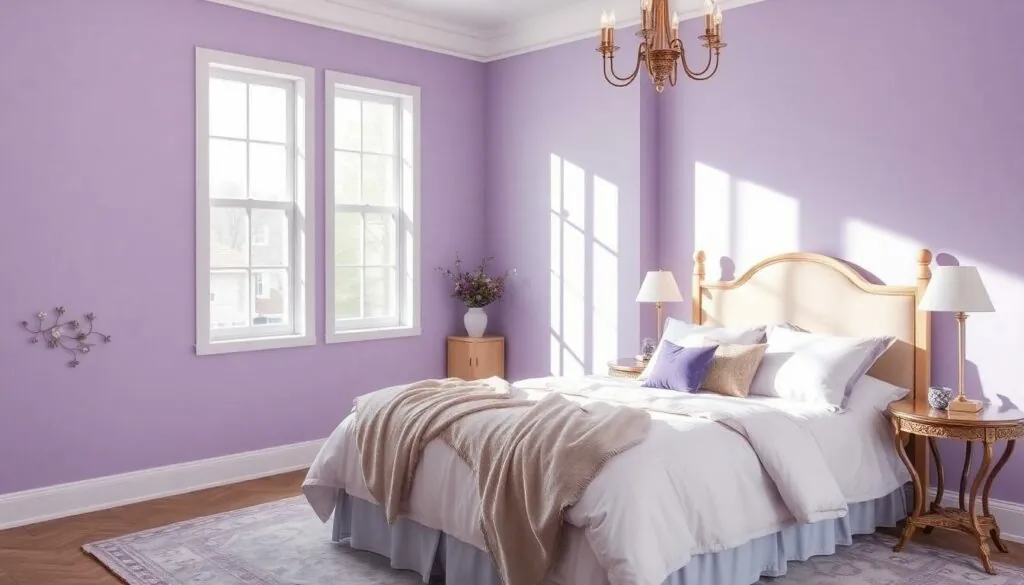Imagine stepping into a bedroom that feels like a cozy hug from a lavender cloud. Purple paint colors have a magical way of transforming spaces, making them feel both serene and stylish. Whether it’s a bold eggplant or a soft lilac, these hues can turn any room into a dreamy retreat where stress takes a backseat and relaxation reigns supreme.
Table of Contents
ToggleOverview of Purple Paint Colors for Bedrooms
Purple paint colors offer a broad spectrum of options for bedroom design. Shades like lavender promote tranquility, making them ideal for relaxation. Darker tones, such as eggplant, create a dramatic yet cozy ambiance, perfect for a statement wall. Soft violet variations infuse spaces with a sense of warmth without overwhelming the senses.
Popular choices include pale lilac, which adds a subtle elegance and pairs well with neutral furniture. Deeper purples complement rich textiles, enhancing a luxurious feel in the room. Selecting the right shade can transform a bedroom into a calm sanctuary.
Accent options exist in lighter shades, allowing for creative combinations. Color contrasts with white or cream create a fresh and airy atmosphere. Incorporating purple accents in decor, like pillows and artwork, ties the room together seamlessly.
In lighting, purple reflects beautifully, especially with warm bulbs. Venturing into statement pieces, such as a purple headboard or decorative accents, highlights the color’s versatility. Room sizes influence color choice; lighter hues tend to open up smaller spaces while darker tones provide intimacy in larger rooms.
Texture plays a role in how paint colors appear; matte finishes absorb light, while satin or glossy surfaces reflect it, creating different moods. Trendy in recent years, purple paint enhances both contemporary and traditional decor styles. Choosing the right purple aligns personal style with the desired emotional impact, ensuring the bedroom remains a personalized retreat.
Purple paint colors offer dynamic options for designing inviting and stylish bedrooms, supporting individual expression and creating a nurturing environment.
Popular Shades of Purple

Purple paint colors offer a wide range of options suitable for bedroom decor, allowing for unique expressions of style and comfort. Light and dark shades create differing atmospheres, influencing the overall mood of a space.
Light Purple Shades
Light purple shades evoke a soft, tranquil ambiance. Lavender provides a gentle touch that enhances relaxation. Lilac adds a hint of sweetness, perfect for creating a calming atmosphere. Mauve introduces a slightly muted elegance, which works well with various furniture styles. Soft heliotrope offers subtle pops of color while maintaining a serene environment, ideal for restful sleep. These hues effectively brighten a room without overwhelming the senses.
Dark Purple Shades
Dark purple shades bring depth and drama to bedroom spaces. Eggplant stands out as a bold choice, exuding luxury and sophistication. Deep plum creates a cocooning effect, promoting a restful retreat. Aubergine, with its rich undertones, brings warmth while adding dimension to the walls. Dark lavender provides a unique blend of light and shadow, lending a cozy feel. These shades can be complemented with strategic accent colors to enhance visual interest.
Choosing the Right Purple for Your Space
Selecting the perfect shade of purple is key to enhancing any bedroom. Factors such as room size and lighting significantly influence color perception.
Consider Room Size and Lighting
Room size directly affects how colors appear. Smaller bedrooms benefit from lighter shades, like lavender or lilac, which create an illusion of space. In contrast, larger rooms can accommodate deeper colors, such as eggplant or aubergine, adding warmth without feeling cramped. Natural light also plays a critical role. A brightly lit room can showcase both light and dark purples effectively, while dim lighting softens bold hues, creating an intimate atmosphere. Experimentation with samples on walls helps determine how lighting transforms the chosen shade throughout the day.
Complementary Colors and Decor
Choosing complementary colors enhances the visual appeal of purple paint. Soft neutrals, including cream and gray, balance the boldness of purple, creating a harmonious palette. Pairing purple with accents such as gold or silver promotes a luxurious feel. Darker purples can be paired with bright yellow or teal for striking contrast, adding vibrancy without overwhelming the space. Accessories like bedding, curtains, and artwork should harmonize with the purple walls to achieve a cohesive look. Thoughtfully selecting decor elements around the purple hue ensures the room feels well-designed and inviting.
Tips for Painting a Bedroom
Choosing the right shade of purple significantly influences the room’s atmosphere. Consider lighter purples like lavender or soft lilac for a calming effect. Darker shades such as eggplant or deep plum can create an inviting, luxurious space.
Selecting paint finish matters, too. Satin or eggshell finishes offer a subtle sheen, enhancing the color while adding warmth. Matte finishes provide a soft look but may require more frequent touch-ups.
Lighting plays a crucial role in color perception. Natural light can shift hues throughout the day, so understanding the room’s lighting helps in making informed decisions. Test paint samples on walls and observe them at different times to see how they change.
Preparation steps are vital before starting the painting process. Clean surfaces thoroughly to ensure proper adhesion. Applying painter’s tape around edges and trim leads to cleaner lines. Using a primer can enhance the final appearance and improve paint longevity.
Ventilation remains important during the painting process. Open windows, allowing fresh air to circulate, ensures a comfortable working environment. It also helps paint dry evenly.
When selecting complementary colors, balance is key. Soft neutrals can tone down vibrant purples, while bold accents provide a striking contrast. Incorporate furniture or accessories in these colors for a cohesive look.
Incorporating textures with paints can elevate design. Textured walls or various fabric elements like pillows and curtains bring depth to the space. Lastly, layering light sources through lamps and fixtures enhances the overall ambiance, making the room feel inviting and warm.
Choosing the right purple paint color can truly elevate a bedroom’s ambiance. Whether opting for soft lavender or bold eggplant each shade offers unique benefits that cater to individual tastes and room dynamics. It’s essential to consider factors like room size and lighting to ensure the chosen hue enhances the overall atmosphere.
By thoughtfully pairing purple with complementary colors and textures a bedroom can transform into a serene retreat that reflects personal style. With careful planning and execution the result will be a cozy space that invites relaxation and rejuvenation. Embracing the versatility of purple opens up a world of design possibilities, making it a compelling choice for any bedroom.



